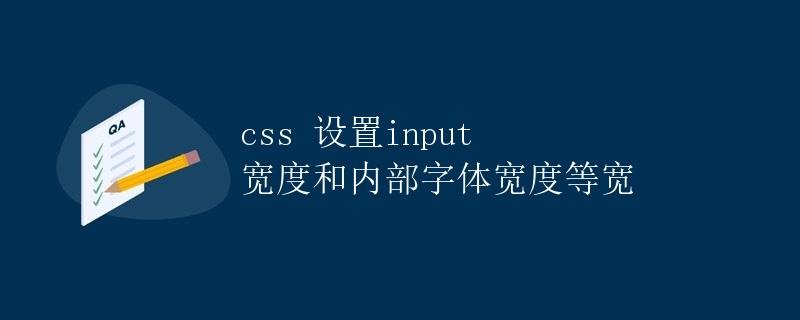CSS sets input width to be equal to internal font width
CSS sets input width and internal font width to be equal

In front-end development, you often need to set the width of an input box to the same width as the internal font width. This makes the input box more aesthetically pleasing and makes user input more intuitive. This article will explain in detail how to achieve this effect using CSS.
1. Setting Input Box Width
First, let’s look at how to set the width of an input box. Generally speaking, the width property in CSS allows you to directly set the width of an element. For example, we can set the width of an input box to 200px like this:
input {
width: 200px;
}
This sets the width of the input box to 200px. However, if we want the width of the input box to match the width of the font within it, this simple setting is not enough. Next, we’ll explain how to achieve this effect using CSS.
2. Setting the Width of the Font Within the Input Box to a Fixed Width
To achieve a fixed width for the font within the input box, we can use the font-family and letter-spacing properties in CSS. First, set the input box’s font-family to a fixed-width font, such as monospace. Then, use the letter-spacing property to adjust the spacing between the characters so that each character has an equal width.
input {
font-family: monospace;
letter-spacing: 0.25em;
}
This setting will change the font inside the input box to a monospaced font, with each character having the same width. You can also adjust the value of letter-spacing to achieve a more customized effect.
3. Complete Example
Here is a complete example showing how to make the width of the input box equal to the internal font width:
<!DOCTYPE html>
<html Tutorial">html lang="en">
<head>
<meta charset="UTF-8">
<meta http-equiv="X-UA-Compatible" content="IE=edge">
<meta name="viewport" content="width=device-width, initial-scale=1.0">
<title>Input Width and Font Width Equal</title>
<style>
input {
width: 200px;
font-family: monospace;
letter-spacing: 0.25em;
}
</style>
</head>
<body>
<input type="text" placeholder="Type something...">
</body>
</html>
In this example, we set the width of the input box to 200px, set the font inside the input box to a monospaced font, and adjust the font spacing so that each character has an equal width. You can run this example in your browser to see the effect.
Conclusion
Through this article, you’ve learned how to use CSS to set the width of an input box to match the width of the font inside it.